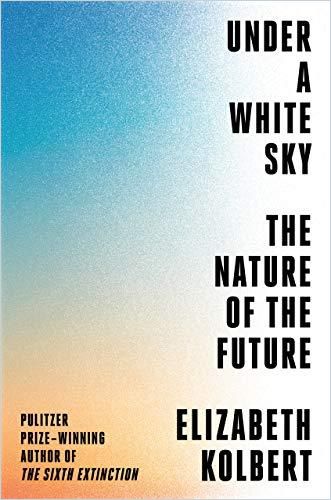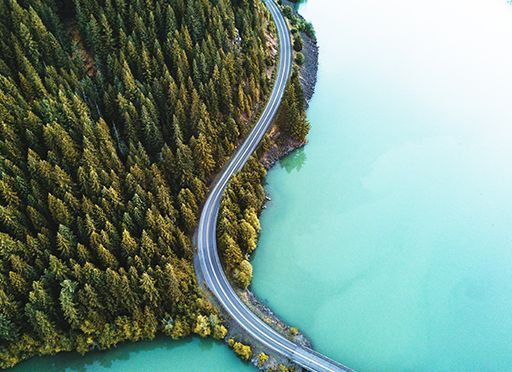Pulitzer Prize–winning author Elizabeth Kolbert explores the dire effects of climate change and humanity’s mostly feckless interfering with nature.

Unforseen Consequences
Pulitzer Prize–winning author and New Yorker staff writer Elizabeth Kolbert – a visiting fellow at Williams College’s Center for Environmental Studies – journeys to the world’s most vulnerable ecosystems, seeking answers to the climate change dilemma. She meets scientists dedicated to saving coral reefs, managing Louisiana’s coastline and solar geoengineering to slow global warming. Kolbert details how humanity excels at solving problems, but proves incompetent at predicting or managing unintended consequences.
Asian Carp
In the early 20th century, the Chicago River, which flowed into Lake Michigan, overflowed with human waste, tainting the lake’s drinking water and causing cholera and typhoid outbreaks. The solution: Reverse the river’s flow via a canal to send the waste toward the Mississippi River, and thence to the Gulf of Mexico. This allowed the Asian carp – an invasive species that could devastate the Great Lakes fragile ecology – to enter Lake Michigan. The solution? Electrify the river to drive back the Asian carp.
If there is to be an answer to the problem of control, it’s going to be more control.Elizabeth Kolbert
When humans intervene in the natural world, the natural world introduces new problems, which require more human interventions. Human proliferation has led to atmospheric warming, ocean acidification and extinctions. For good or ill, Kolbert determines that nature will inevitably change as humans intervene to fix problems they created.
New Orleans
At the time of the Louisiana Purchase in 1803, the Mississippi River dropped 400 million tons of sediment annually. This sediment shaped the Louisiana coastline, creating deltas where settlements formed, including New Orleans in 1718. Dating back to the 1730s, enslaved Africans built levees to protect the city, and with each new flood, the levees grew higher and wider and longer, spanning hundreds of miles.
People are ingenious. They come up with crazy, big ideas, and sometimes these actually work.Elizabeth Kolbert
In preventing floods, levees robbed the region of much-needed sediment. The massive 1950s Old River Control Auxiliary Structure led the river where the US Army Corps of Engineers thought it should go. Hurricane Katrina proved this to be hubris of the most destructive sort.
In New Orleans, pumps have been driving out water since 1920. The swampy regions compact, causing land to sink. The more the city pumps, the faster it sinks, necessitating more pumping. Eventually, New Orleans will be an island.
Coral Reefs
More species live on a patch of healthy coral reef than in any comparable ecosystem, including the Amazon rain forest. Marine heat waves devastate their intricate ecology. Were the reefs to disappear, much ocean life would die.
Our project is acknowledging that a future is coming where nature is no longer fully natural.Elizabeth Kolbert
Scientists seek to breed hardier corals to withstand extreme temperature and acid levels. More extreme interventions include robotic reseeding, pumping cold water from the ocean depths, and cloud-seeding to create an artificial fog to slow ocean warming.
Negative Emissions
Between 1800 and 1900, carbon emissions increased from 30 million to two billion tons. Between 1900 and 2020, emissions grew to over 40 billion tons annually as global temperatures rose by 1.1°C. To keep the planet from warming to a catastrophic 2°C, global emissions must fall to almost zero. To produce negative emissions, humans must pull carbon from the air.
To remove the carbon requires energy; that energy would mostly come from fossil fuels. After capture, carbon must be safely stored, and that can be expensive and impractical.
A trillion trees, for example, could remove 200 billion tons of carbon in a few decades. Rotting trees would be buried to prevent CO2 being released again. Bioenergy carbon capture and storage (BECCS) solutions would burn the trees to produce electricity and pull out the carbon, driving it underground. But two trillion trees require a landmass the size of the United States. Trees taking over arable land would starve millions. Trees are dark and absorb heat, thus requiring a genetically modified, lighter-colored tree.
Solar Geoengineering
Volcanoes cool the planet. Sulfur dioxide and small particles scatter sunlight, driving down temperatures and plant growth. The Harvard Solar Geoengineering Research Program proposes mimicking volcanoes by throwing “a gazillion reflective particles” into the upper atmosphere to inhibit sunlight. This drastic approach carries unknown, unintended consequences, but time is running out for human intervention.
Scientists believe the world requires a combination of solar geoengineering, carbon emissions reduction, investment in renewable energy and carbon capture.
Engineering efforts may be the best chance for survival for most of the Earth’s natural ecosystems – although perhaps they should no longer be called natural if such engineering systems are ever deployed.Elizabeth Kolbert
Human intervention creates new problems while solving old ones. Failed geoengineering would spike warming, potentially devastating all life on Earth. Using aircraft to disperse particles requires CO2-emitting fuels and 40,000 planes a year; the particles would turn the sky from blue to white, disrupt rainfall patterns, reduce solar energy production and perhaps cause famine.
Meddling
Massive interventions loom. New York City, for example, is investing in building artificial islands in New York Harbor and connecting them with retractable gates to protect against surge. The bigger the problem, the bigger the solution, which creates another big problem that inevitably requires an even bigger solution. Humanity’s track record suggests that no good will come from more meddling with nature.
Gravitas and Terror
Elizabeth Kolbert’s signature style features her calm, sober voice, no matter how horrifying the climate issues she reports. She doesn’t have to exaggerate to make her points; Kolbert’s reportorial remove makes the issues she illuminates all the more terrifying. Her calmness grants her an incontrovertible gravitas as her carefully researched facts illustrate her theme. Kolbert’s writing, as ever, is gripping and readable. She may not answer every question she raises, but nobody else could, either. Kolbert provides an indispensable, compelling overview for anyone concerned with Earth’s future.
Elizabeth Kolbert also wrote The Sixth Extinction; Field Notes for a Catastrophe; and The Prophet of Love.




